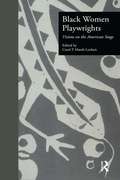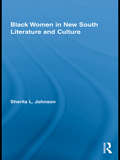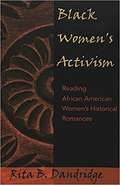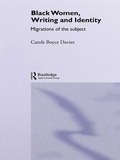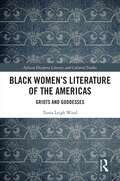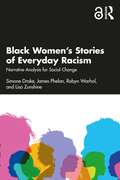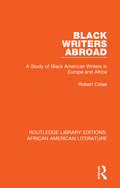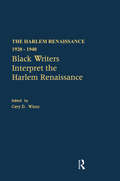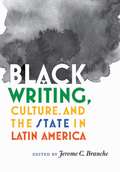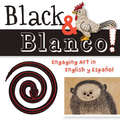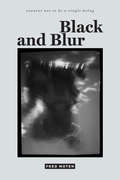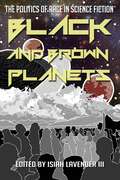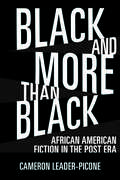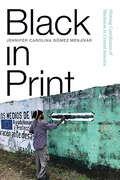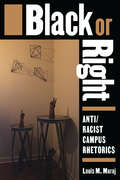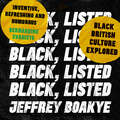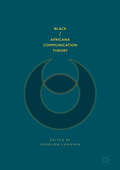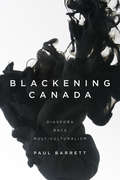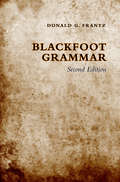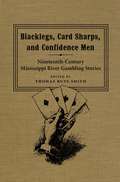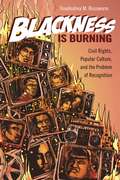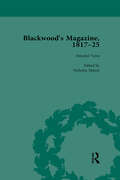- Table View
- List View
Black Women Playwrights: Visions on the American Stage (Studies in Modern Drama #Vol. 11)
by Carol P. Marsh-LockettFirst published in 1999. Routledge is an imprint of Taylor & Francis, an informa company.
Black Women in New South Literature and Culture (Studies in American Popular History and Culture)
by Sherita L. JohnsonUsing the "the Negro Problem" in African American literature as a point of departure, this book focuses on the profound impact that racism had on the literary imagination of black Americans, specifically those in the South. Although the South has been one of the most enduring sites of criticism in American Studies and in American literary history, Johnson argues that it is impossible to consider what the "South" and what "southernness" mean as cultural references without looking at how black women have contributed to and contested any unified definition of that region. Johnson challenges the homogeneity of a "white" South and southern cultural identity by recognizing how fictional and historical black women are underacknowledged agents of cultural change. Johnson regards the South as a cultural region that (re)constructs black womanhood, but she also considers how black womanhood have transformed the South. Specialists in nineteenth and twentieth century American literature will find this book a necessary addition, as will scholars of African American Literature and History.
Black Women's Activism: Reading African American Women's Historical Romances (African-American Literature and Culture #5)
by Rita B. DandridgeBlack Women’s Activism is the first book-length study of African American women’s historical romances. This book examines romances written from 1989 to the present, and discusses their black heroines’ resistance at particular moments in history – from the colonization movement to the Texas oil boom. Socio-historical perspectives, a womanist agenda, and an African-centered outlook inform the readings of female characters in the narratives of Francine Craft, Gay G. Gunn, Shirley Hailstock, Beverly Jenkins, and Anita Richmond Bunkley. Broadening the scope of the historical romance genre, and expanding the canon of African American literature, this book provides a more comprehensive image of the black female character and addresses gender issues previously unexplored in black fiction. This text should be used by librarians, historians, literary critics, writers, college- and graduate-level students, teachers, and romance readers.
Black Women, Writing and Identity: Migrations of the Subject
by Carole Boyce-DaviesBlack Women Writing and Identity is an exciting work by one of the most imaginative and acute writers around. The book explores a complex and fascinating set of interrelated issues, establishing the significance of such wide-ranging subjects as: * re-mapping, re-naming and cultural crossings * tourist ideologies and playful world travelling * gender, heritage and identity * African women's writing and resistance to domination * marginality, effacement and decentering * gender, language and the politics of location Carole Boyce-Davies is at the forefront of attempts to broaden the discourse surrounding the representation of and by black women and women of colour. Black Women Writing and Identity represents an extraordinary achievement in this field, taking our understanding of identity, location and representation to new levels.
Black Women’s Literature of the Americas: Griots and Goddesses (Routledge African Diaspora Literary and Cultural Studies)
by Tonia Leigh WindDrawing on a range of historical and literary texts, this book examines how Black women under the yoke of slavery negotiated their sense of belonging and spirituality from a liminal position, stuck between a new life in the Americas, and their connections to their African ancestral roots and a wider diasporic community. The book investigates how Black women in the Spanish-speaking Caribbean, the United States, and Brazil turned to their spiritual beliefs as a tool of resilience and resistance. These “griots” and “goddesses” are forced to negotiate complex issues such as race, gender, identity, maternity, sexuality, and belonging, from a liminal position that looks to both settle roots in a foreign land, and stay connected to ancestors and the Sacred. As these Black female protagonists turn to (re)memory and ancestral knowledge to map their connection with the Divine, they become mediators of worlds, and hybrid griots surpassing temporal and geographical boundaries. With important reflections on Toni Morrison’s Beloved, Dahlma Llanos-Figueroa’s Daughters of the Stone, and Ana Maria Gonçalves’s Um Defeito de Cor, amongst other texts, this book will be of interest to advanced students and researchers of comparative literature, religious studies, gender studies, and African diaspora studies.
Black Women’s Stories of Everyday Racism: Narrative Analysis for Social Change
by James Phelan Robyn Warhol Lisa Zunshine Simone DrakeBlack Women’s Stories of Everyday Racism puts literary narrative theory to work on an urgent real-world problem. The book calls attention to African American women’s everyday experiences with systemic racism and demonstrates how four types of narrative theory can help generate strategies to explain and dismantle that racism. This volume presents fifteen stories told by eight midwestern African American women about their own experiences with casual and structural racism, followed by four detailed narratological analyses of the stories, each representing a different approach to narrative interpretation. The book makes a case for the need to hear the personal stories of these women and others like them as part of a larger effort to counter the systemic racism that prevails in the United States today.Readers will find that the women’s stories offer powerful evidence that African Americans experience racism as an inescapable part of their day-to-day lives—and sometimes as a force that radically changes their lives. The stories provide experience-based demonstrations of how pervasive systemic racism is and how it perpetuates power differentials that are baked into institutions such as schools, law enforcement, the health care system, and business. Containing countless signs of the stress and trauma that accompany and follow from experiences of racism, the stories reveal evidence of the women’s resilience as well as their unending need for it, as they continue to feel the negative effects of experiences that occurred many years ago. The four interpretive chapters note the complex skill involved in the women’s storytelling. The analyses also point to the overall value of telling these stories: how they are sometimes cathartic for the tellers; how they highlight the importance of listening—and the likelihood of misunderstanding—and how, if they and other stories like them were heard more often, they would be a force to counteract the structural racism they so graphically expose.The Open Access version of this book, available at http://www.taylorfrancis.com, has been made available under a Creative Commons Attribution (CC-BY) 4.0 license.
Black Writers Abroad: A Study of Black American Writers in Europe and Africa (Routledge Library Editions: African American Literature #3)
by Robert ColesOriginally published in 1999 Black Writers Abroad puts forward the theory that African American literature was born, partially within the context of a people and its writers who lived, for the most part, in slavery and bondage prior to the Civil War. It is an in-depth study of black American writers who, left the United States as expatriates. The book discusses the people that left, where they went, why they left and why they did or did not return, from the nineteenth century to the twentieth century. It seeks to explain the impact exile had upon these authors’ literary work and careers, as well as upon African American literary history.
Black Writers Interpret the Harlem Renaissance (The Harlem Renaissance 1920-1940 #Vol. 3)
by Cary D. WintzFirst Published in 1996. One of the most interesting features of the Harlem Renaissance was the degree to which black writers and poets were involved in promoting and analyzing their own literary movement. One of its formative events was the 1926 attempt by Wallace Thurman, Langston Hughes and other young writers to publish a literary magazine, FIRE!! This was the first of several efforts by black writers to establish literary journals. While these efforts failed, the magazine Opportunity employed a series of black poets as columnists to analyze and review black literary efforts. This volume collects the writings of this important literary journal as well as including many autobiographical and historical sketches.
Black Writing, Culture, and the State in Latin America
by Jerome BrancheImagine the tension that existed between the emerging nations and governments throughout the Latin American world and the cultural life of former enslaved Africans and their descendants. A world of cultural production, in the form of literature, poetry, art, music, and eventually film, would often simultaneously contravene or cooperate with the newly established order of Latin American nations negotiating independence and a new political and cultural balance. In Black Writing, Culture, and the State in Latin America, Jerome Branche presents the reader with the complex landscape of art and literature among Afro-Hispanic and Latin artists. Branche and his contributors describe individuals such as Juan Francisco Manzano, who wrote an autobiography on the slave experience in Cuba during the nineteenth century. The reader finds a thriving Afro-Hispanic theatrical presence throughout Latin America and even across the Atlantic. The role of black women in poetry and literature comes to the forefront in the Caribbean, presenting a powerful reminder of the diversity that defines the region. All too often, the disciplines of film studies, literary criticism, and art history ignore the opportunity to collaborate in a dialogue. Branche and his contributors present a unified approach, however, suggesting that cultural production should not be viewed narrowly, especially when studying the achievements of the Afro-Latin world.
Black Writing, Culture, and the State in Latin America
by Jerome C. BrancheImagine the tension that existed between the emerging nations and governments throughout the Latin American world and the cultural life of former enslaved Africans and their descendants. A world of cultural production, in the form of literature, poetry, art, music, and eventually film, would often simultaneously contravene or cooperate with the newly established order of Latin American nations negotiating independence and a new political and cultural balance. In Black Writing, Culture, and the State in Latin America, Jerome Branche presents the reader with the complex landscape of art and literature among Afro-Hispanic and Latin artists. Branche and his contributors describe individuals such as Juan Francisco Manzano, who wrote an autobiography on the slave experience in Cuba during the nineteenth century. The reader finds a thriving Afro-Hispanic theatrical presence throughout Latin America and even across the Atlantic. The role of black women in poetry and literature comes to the forefront in the Caribbean, presenting a powerful reminder of the diversity that defines the region.All too often, the disciplines of film studies, literary criticism, and art history ignore the opportunity to collaborate in a dialogue. Branche and his contributors present a unified approach, however, suggesting that cultural production should not be viewed narrowly, especially when studying the achievements of the Afro-Latin world.
Black and Blanco!
by San Antonio Museum of ArtWhat better way to be introduced to the contrasting interplay between black and white than with eye-catching works of art. This bi-lingual edition also introduces children at a young age to both English and Spanish.Art for this book was selected from the collection of the San Antonio Museum of Art, one of the leading art museums in the United States with a collection spanning a broad range of history and world cultures.
Black and Blur
by Fred Moten"Taken as a trilogy, consent not to be a single being is a monumental accomplishment: a brilliant theoretical intervention that might be best described as a powerful case for blackness as a category of analysis."—Brent Hayes Edwards, author of Epistrophies: Jazz and the Literary Imagination In Black and Blur—the first volume in his sublime and compelling trilogy consent not to be a single being—Fred Moten engages in a capacious consideration of the place and force of blackness in African diaspora arts, politics, and life. In these interrelated essays, Moten attends to entanglement, the blurring of borders, and other practices that trouble notions of self-determination and sovereignty within political and aesthetic realms. Black and Blur is marked by unlikely juxtapositions: Althusser informs analyses of rappers Pras and Ol' Dirty Bastard; Shakespeare encounters Stokely Carmichael; thinkers like Kant, Adorno, and José Esteban Muñoz and artists and musicians including Thornton Dial and Cecil Taylor play off each other. Moten holds that blackness encompasses a range of social, aesthetic, and theoretical insurgencies that respond to a shared modernity founded upon the sociological catastrophe of the transatlantic slave trade and settler colonialism. In so doing, he unsettles normative ways of reading, hearing, and seeing, thereby reordering the senses to create new means of knowing.
Black and Brown Planets: The Politics of Race in Science Fiction
by Isiah Lavender IIIBlack and Brown Planets embarks on a timely exploration of the American obsession with color in its look at the sometimes-contrary intersections of politics and race in science fiction. The contributors, including De Witt D. Kilgore, Edward James, Lisa Yaszek, and Marleen S. Barr, among others, explore science fiction worlds of possibility (literature, television, and film), lifting blacks, Latin Americans, and indigenous peoples out from the background of this historically white genre. This collection considers the role of race and ethnicity in our visions of the future. The first section emphasizes the political elements of black identity portrayed in science fiction from black America to the vast reaches of interstellar space framed by racial history. In the next section, analysis of indigenous science fiction addresses the effects of colonization, helps discard the emotional and psychological baggage carried from its impact, and recovers ancestral traditions in order to adapt in a post-Native-apocalyptic world. Likewise, this section explores the affinity between science fiction and subjectivity in Latin American cultures from the role of science and industrialization to the effects of being in and moving between two cultures. By infusing more color in this otherwise monochrome genre, Black and Brown Planets imagines alternate racial galaxies with viable political futures in which people of color determine human destiny.
Black and More than Black: African American Fiction in the Post Era (Margaret Walker Alexander Series in African American Studies)
by Cameron Leader-PiconeCHOICE Outstanding Academic Title for 2020Post-Blackness. Post-Soul. Post-Black Art. New Blackness. How has the meaning of blackness changed in the twenty-first century? Cameron Leader-Picone suggests that this proliferation of terms, along with the renewed focus on questioning the relationship between individual black artists and the larger black community, indicates the arrival of novel forms of black identity and black art. Leader-Picone defines these terms as significant facets of a larger post era, linking them with the social and political context of Barack Obama’s presidency. Analyzing claims of progress associated with Obama’s election and post-era thinking, he examines the contours of black aesthetics in the new century. To do so, he sifts through post-era African American fiction, considering both celebrations and rejections of an early twenty-first-century rhetoric of progress. In addition, he maps the subsequent implications of these concepts for rearticulating racial identities. Through the works of Colson Whitehead, Alice Randall, Chimamanda Ngozi Adichie, Paul Beatty, Kiese Laymon, and Jesmyn Ward, Leader-Picone tracks how recent fiction manifests the tension between the embrace of post–civil rights era gains and the recognition of persistent structural racism. Ultimately far less triumphal than the prefix post would imply, these authors address the Black Arts Movement and revise double consciousness and other key themes from the African American literary tradition. They interrogate their relevance in an era encompassing not only the election of the nation’s first black president, but also the government’s failed response to Hurricane Katrina, the expansion of class divisions within the black community, mass incarceration, and ongoing police violence.
Black in Print: Plotting the Coordinates of Blackness in Central America (SUNY series, Afro-Latinx Futures)
by Jennifer Carolina Gómez MenjívarBlack in Print examines the role of narrative, from traditional writing to new media, in conversations about race and belonging in the isthmus. It argues that the production, circulation, and consumption of stories has led to a trans-isthmian imaginary that splits the region along racial and geographic lines into a white-mestizo Pacific coast, an Indigenous core, and a Black Caribbean. Across five chapters, Jennifer Carolina Gómez Menjívar identifies a series of key moments in the history of the development of this imaginary: Independence, Intervention, Cold-War, Post-Revolutionary, and Digital Age. Gómez Menjívar's analysis ranges from literary beacons such as Rubén Darío and Miguel Ángel Asturias to less studied intellectuals such as Wingston González and Carl Rigby. The result is a fresh approach to race, the region, and its literature. Black in Print understands Central American Blackness as a set of shifting coordinates plotted on the axes of language, geography, and time as it moves through print media.
Black or Right: Anti/Racist Campus Rhetorics
by Louis M. MarajBlack or Right: Anti/Racist Campus Rhetorics explores notions of Blackness in white institutional—particularly educational—spaces. In it, Louis M. Maraj theorizes how Black identity operates with/against ideas of difference in the age of #BlackLivesMatter. Centering Blackness in frameworks for antiracist agency through interdisciplinary Black feminist lenses, Black or Right asks how those racially signifying “diversity” in US higher education (and beyond) make meaning in the everyday. Offering four Black rhetorics as antiracist means for rhetorical reclamation—autoethnography, hashtagging, inter(con)textual reading, and reconceptualized disruption—the book uses Black feminist relationality via an African indigenous approach. Maraj examines fluid, quotidian ways Black folk engage anti/racism at historically white institutions in the United States in response to violent campus spaces, educational structures, protest movements, and policy practice. Black or Right’s experimental, creative style strives to undiscipline knowledge from academic confinement. Exercising different vantage points in each chapter—autoethnographer, digital media scholar/pedagogue, cultural rhetorician, and critical discourse analyst—Maraj challenges readers to ecologically understand shifting, multiple meanings of Blackness in knowledge-making. Black or Right’s expressive form, organization, narratives, and poetics intimately interweave with its argument that Black folk must continuously invent “otherwise” in reiterative escape from oppressive white spaces. In centering Black experiences, Black theory, and diasporic Blackness, Black or Right mobilizes generative approaches to destabilizing institutional whiteness, as opposed to reparative attempts to “fix racism,” which often paradoxically center whiteness. It will be of interest to both academic and general readers and significant for specialists in cultural rhetorics, Black studies, and critical theory.
Black to Nature: Pastoral Return and African American Culture
by Stefanie K. DunningIn Black to Nature: Pastoral Return and African American Culture, author Stefanie K. Dunning considers both popular and literary texts that range from Beyoncé’s Lemonade to Jesmyn Ward’s Salvage the Bones. These key works restage Black women in relation to nature. Dunning argues that depictions of protagonists who return to pastoral settings contest the violent and racist history that incentivized Black disavowal of the natural world. Dunning offers an original theoretical paradigm for thinking through race and nature by showing that diverse constructions of nature in these texts are deployed as a means of rescrambling the teleology of the Western progress narrative. In a series of fascinating close readings of contemporary Black texts, she reveals how a range of artists evoke nature to suggest that interbeing with nature signals a call for what Jared Sexton calls “the dream of Black Studies”—abolition. Black to Nature thus offers nuanced readings that advance an emerging body of critical and creative work at the nexus of Blackness, gender, and nature. Written in a clear, approachable, and multilayered style that aims to be as poignant as nature itself, the volume offers a unique combination of theoretical breadth, narrative beauty, and broader perspective that suggests it will be a foundational text in a new critical turn towards framing nature within a cultural studies context.
Black, Listed: Black British Culture Explored
by Jeffrey BoakyeAFRO-CARIBBEAN. COLOURED. ETHNIC MINORITY. IMMIGRANT. BAME. URBAN. WOKE. FAM. BLACK.These are just some of the terms being wrestled with in Black, Listed, an exploration of twenty-first century Black identity told through a list of insults, insights and everything in between. Taking a panoramic look at global Black history and contemporary culture, this book investigates the ways in which Black communities (and individuals) have been represented, oppressed, mimicked, celebrated and othered. Part autobiographical musing, part pop culture vivisection, it's a comprehensive attempt to make sense of blackness from the vantage point of the hilarious and insightful psyche of Jeffrey Boakye. PRAISE FOR BLACK, LISTED: 'This book gives a voice to those whose experience is persistently defined, refined and denied by others' David Lammy, Guardian 'A panoramic exploration of black identity' Elle'Urgent, timely reading' AnOther Magazine 'Inventive, refreshing and humorous' Bernardine Evaristo, author of Girl, Woman, Other 'A truly radical book, which manages to be unflinching and constantly entertaining' Caroline Sanderson, The Bookseller
Black, Listed: Black British Culture Explored
by Jeffrey BoakyeGUARDIAN MUST READ BOOKS OF 2019 FINANCIAL TIMES BOOKS TO READ 2019 NEW STATESMAN MUST READS 2019'A truly radical book, which manages to be unflinching and constantly entertaining' CAROLINE SANDERSON, THE BOOKSELLER BOOK OF THE MONTH APRIL 2019'This book gives a voice to those whose experience is persistently defined, refined and denied by others' DAVID LAMMY, GUARDIAN *Who is a roadman really? What's wrong with calling someone a 'lighty'? Why do people think black guys are cool?These are just some of the questions being wrestled with in Black, Listed, an exploration of 21st century black identity told through a list of insults, insights and everything in-between.Taking a panoramic look at global black history, interrogating both contemporary and historical culture, Black, Listed investigates the ways in which black communities (and individuals) have been represented, oppressed, mimicked, celebrated, and othered. Part historical study, part autobiographical musing, part pop culture vivisection, it's a comprehensive attempt to make sense of blackness from the vantage point of the hilarious and insightful psyche of Jeffrey Boakye. Along the way, it explores a far reaching range of social and cultural contexts, including but not limited to, sport, art, entertainment, politics, literature, history, music, theatre, cinema, education and criminal justice, sometimes at the same time.
Black/Africana Communication Theory
by Kehbuma LangmiaMost Western-driven theories do not have a place in Black communicative experience, especially in Africa. Many scholars interested in articulating and interrogating Black communication scholarship are therefore at the crossroads of either having to use Western-driven theory to explain a Black communication dynamic, or have to use hypothetical rules to achieve their objectives, since they cannot find compelling Black communication theories to use as reference. Colonization and the African slave trade brought with it assimilationist tendencies that have dealt a serious blow on the cognition of most Blacks on the continent and abroad. As a result, their interpersonal as well as in-group dialogic communication had witnessed dramatic shifts. Black/Africana Communication Theory assembles skilled communicologists who propose uniquely Black-driven theories that stand the test of time. Throughout the volume’s fifteen chapters theories including but not limited to Afrocentricity, Afro-Cultural Mulatto, Venerative Speech Theory, Africana Symbolic Contextualism Theory, HaramBuntu-Government-Diaspora Communications Theory, Consciencist Communication Theory and Racial Democracy Effect Theory are introduced and discussed.
Blackening Canada
by Paul BarrettFocusing on the work of black, diasporic writers in Canada, particularly Dionne Brand, Austin Clarke, and Tessa McWatt, Blackening Canada investigates the manner in which literature can transform conceptions of nation and diaspora. Through a consideration of literary representation, public discourse, and the language of political protest, Paul Barrett argues that Canadian multiculturalism uniquely enables black diasporic writers to transform national literature and identity. These writers seize upon the ambiguities and tensions within Canadian discourses of nation to rewrite the nation from a black, diasporic perspective, converting exclusion from the national discourse into the impetus for their creative endeavours.Within this context, Barrett suggests, debates over who counts as Canadian, the limits of tolerance, and the breaking points of Canadian multiculturalism serve not as signs of multiculturalism's failure but as proof of both its vitality and of the unique challenges that black writing in Canada poses to multicultural politics and the nation itself.
Blackfoot Grammar
by Donald G. FrantzThousands of people in Alberta and Montana speak Blackfoot, an Algonquian language. But the numbers are diminishing and the survival of Blackfoot is in some danger. To help preserve the language while it is still in daily use, Donald G. Frantz and Norma Jean Russell collaborated on the Blackfoot Dictionary, published in 1989 to widespread acclaim and later revised in 1995. Blackfoot Grammar, the companion volume to the dictionary, has now also been updated with a second edition. The changes made to each chapter reflect new approaches refined through years of teaching experience. New chapters on 'Numbers and Enumeration' and 'Translating from English to Blackfoot' have been added, as well as new exercises and two new appendixes describing the phonetics of Blackfoot and the design of the alphabet.This second edition of Blackfoot Grammar will be a welcome update not only for those who wish to learn the language, but for all those with an interest in Native Studies and North American linguistics.
Blacklegs, Card Sharps, and Confidence Men: Nineteenth-Century Mississippi River Gambling Stories (Southern Literary Studies)
by Thomas Ruys SmithIn 1836 Benjamin Drake, a midwestern writer of popular sketches for newspapers of the day, introduced his readers to a new and distinctly American rascal who rode the steamboats up and down the Mississippi and other western waterways -- the riverboat gambler. These men, he recorded, "dress with taste and elegance; carry gold chronometers in their pockets; and swear with the most genteel precision.... Every where throughout the valley, these mistletoe gentry are called by the original, if not altogether classic, cognomen of 'Black-legs.'" In Blacklegs, Card Sharps, and Confidence Men, Thomas Ruys Smith collects nineteenth-century stories, sketches, and book excerpts by a gallery of authors to create a comprehensive collection of writings about the riverboat gambler. Long an iconic figure in American myth and popular culture but, strangely, one that has never until now received a book-length treatment, the Mississippi River gambler was a favorite character throughout the nineteenth century -- one often rich with moral ambiguities that remain unresolved to this day.In the absorbing fictional and nonfictional accounts of high stakes and sudden reversals of fortune found in the pages of Smith's book, the voices of canonized writers such as William Dean Howells, Herman Melville, and, of course, Mark Twain hold prominent positions. But they mingle seamlessly with lesser-known pieces such as an excerpt from Edward Willett's sensationalistic dime novel Flush Fred's Full Hand, raucous sketches by anonymous Old Southwestern humorists from the Spirit of the Times, and colorful accounts by now nearly forgotten authors such as Daniel R. Hundley and George W. Featherstonhaugh. Smith puts the twenty-eight selections in perspective with an Introduction that thoroughly explores the history and myth surrounding this endlessly fascinating American cultural icon. While the riverboat gambler may no longer ply his trade along the Mississippi, Blacklegs, Card Sharps, and Confidence Men makes clear the ways in which he still operates quite successfully in the American imagination.
Blackness Is Burning: Civil Rights, Popular Culture, and the Problem of Recognition (Contemporary Approaches to Film and Media Series)
by Treaandrea M. RusswormBlackness Is Burning is one of the first books to examine the ways race and psychological rhetoric collided in the public and popular culture of the civil rights era. In analyzing a range of media forms, including Sidney Poitier’s popular films, black mother and daughter family melodramas, Bill Cosby’s comedy routine and cartoon Fat Albert, pulpy black pimp narratives, and several aspects of post–civil rights black/American culture, TreaAndrea M. Russworm identifies and problematizes the many ways in which psychoanalytic culture has functioned as a governing racial ideology that is built around a flawed understanding of trying to “recognize” the racial other as human. The main argument of Blackness Is Burning is that humanizing, or trying to represent in narrative and popular culture that #BlackLivesMatter, has long been barely attainable and impossible to sustain cultural agenda. But Blackness Is Burning makes two additional interdisciplinary interventions: the book makes a historical and temporal intervention because Russworm is committed to showing the relationship between civil rights discourses on theories of recognition and how we continue to represent and talk about race today. The book also makes a formal intervention since the chapter-length case studies take seemingly banal popular forms seriously. She argues that the popular forms and disreputable works are integral parts of our shared cultural knowledge. Blackness Is Burning’s interdisciplinary reach is what makes it a vital component to nearly any scholar’s library, particularly those with an interest in African American popular culture, film and media studies, or psychoanalytic theory.
Blackwood's Magazine, 1817-25, Volume 1: Selections from Maga's Infancy
by Mark Parker John Strachan Tom Mole Nicholas Mason Anthony JarrellsContextualizes and annotates the influential, scandalous, and entertaining texts which appeared in the Blackwood's Magazine between 1817 and 1825. This title features a detailed general introduction, volume introductions and endnotes, providing the reader with an understanding of the origins and early history of Blackwood's Magazine.
